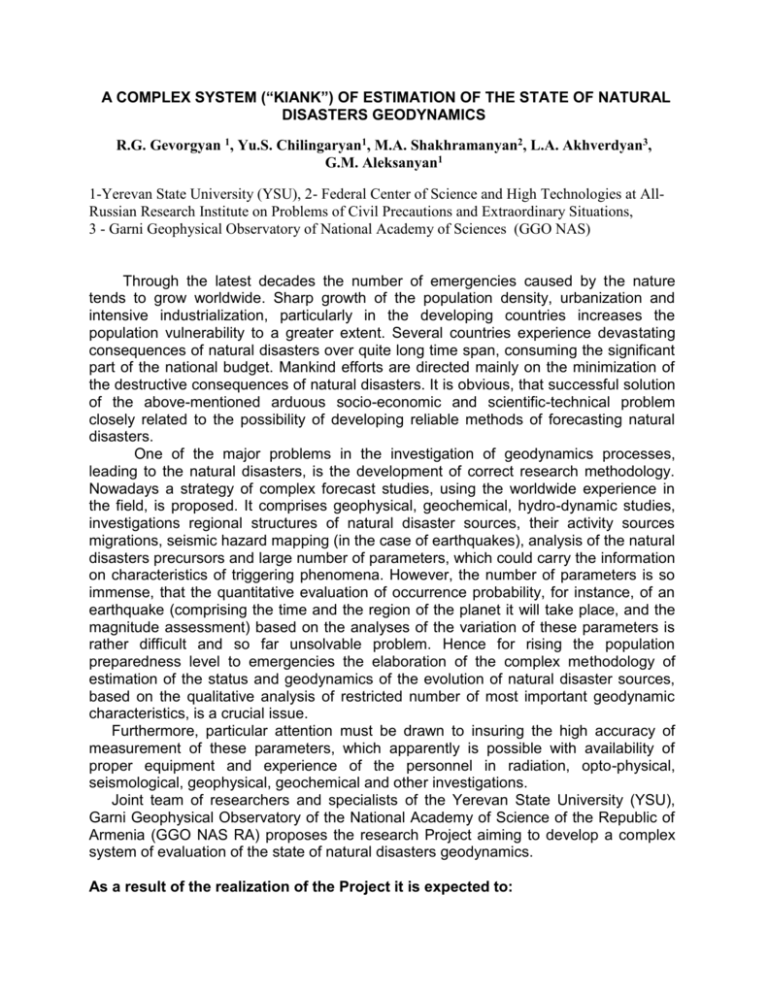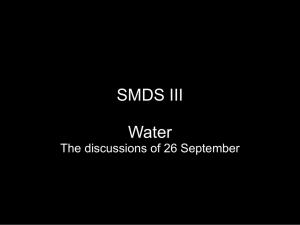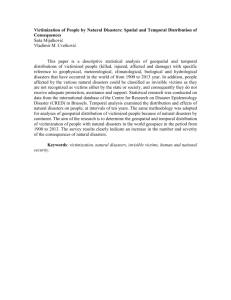37 KB - unisdr
advertisement

A COMPLEX SYSTEM (“KIANK”) OF ESTIMATION OF THE STATE OF NATURAL DISASTERS GEODYNAMICS R.G. Gevorgyan 1, Yu.S. Chilingaryan1, M.A. Shakhramanyan2, L.A. Akhverdyan3, G.M. Aleksanyan1 1-Yerevan State University (YSU), 2- Federal Center of Science and High Technologies at AllRussian Research Institute on Problems of Civil Precautions and Extraordinary Situations, 3 - Garni Geophysical Observatory of National Academy of Sciences (GGO NAS) Through the latest decades the number of emergencies caused by the nature tends to grow worldwide. Sharp growth of the population density, urbanization and intensive industrialization, particularly in the developing countries increases the population vulnerability to a greater extent. Several countries experience devastating consequences of natural disasters over quite long time span, consuming the significant part of the national budget. Mankind efforts are directed mainly on the minimization of the destructive consequences of natural disasters. It is obvious, that successful solution of the above-mentioned arduous socio-economic and scientific-technical problem closely related to the possibility of developing reliable methods of forecasting natural disasters. One of the major problems in the investigation of geodynamics processes, leading to the natural disasters, is the development of correct research methodology. Nowadays a strategy of complex forecast studies, using the worldwide experience in the field, is proposed. It comprises geophysical, geochemical, hydro-dynamic studies, investigations regional structures of natural disaster sources, their activity sources migrations, seismic hazard mapping (in the case of earthquakes), analysis of the natural disasters precursors and large number of parameters, which could carry the information on characteristics of triggering phenomena. However, the number of parameters is so immense, that the quantitative evaluation of occurrence probability, for instance, of an earthquake (comprising the time and the region of the planet it will take place, and the magnitude assessment) based on the analyses of the variation of these parameters is rather difficult and so far unsolvable problem. Hence for rising the population preparedness level to emergencies the elaboration of the complex methodology of estimation of the status and geodynamics of the evolution of natural disaster sources, based on the qualitative analysis of restricted number of most important geodynamic characteristics, is a crucial issue. Furthermore, particular attention must be drawn to insuring the high accuracy of measurement of these parameters, which apparently is possible with availability of proper equipment and experience of the personnel in radiation, opto-physical, seismological, geophysical, geochemical and other investigations. Joint team of researchers and specialists of the Yerevan State University (YSU), Garni Geophysical Observatory of the National Academy of Science of the Republic of Armenia (GGO NAS RA) proposes the research Project aiming to develop a complex system of evaluation of the state of natural disasters geodynamics. As a result of the realization of the Project it is expected to: 1. Develop a set of new opto-electronic measurements system, including highly sensitive liquid crystal sensor for the seismic vibrations registration. The ultimate sensitivity of the former exceeds two to three orders existing counterparts. 2. Develop an experimental polygon based on the "KIANK" monitoring system for the natural disasters geodynamics assessment. 3. Develop a set of algorithms and software on geodynamic processes database processing. 4. Determine the set of the most effective and reliable characteristics of the natural disasters' sources state assessment. 5. Elaborate the methodology of estimation of the state and geodynamics of the natural disaster sources. 6. Assess the hazard level for adequate decision-making in order to enhance the preparedness of NPP and other major engineering structures to emergencies in case of nature caused emergencies within the polygon territory (R=50 km). 7. Develop automated geoinformation system (GIS) principal scheme on the ground of investigations of regional geodynamic processes data. 8. Develop the polygon (Garni-Yerevan-Armenian NPP, Scale 1:50 000) geoecological working GIS model . 9. Integrate the efforts of the scientist of the region (Russia, Turkey, Iran, and countries of the Near East, Central Asia and Transcaucasia) with the wide experience of Armenian scientists in the study of natural disasters obtained throughout the recent decades. Hence attain higher level of international collaboration and cooperation in the struggle with natural disasters. "KIANK" system will be crucial in natural disasters' impact reduction and mitigation by recommending to use its advanced technological know-how. The problem of creating similar systems was advanced on the foreground by such widely accepted authorities as UN, European union (EU) and others international organizations. The maximum effect from "KIANK" might be expected upon the integration of all local and regional systems within a consolidated global system. Expected Results and their Application It is expected, that the realization of the Project will result in obtaining significant scientific results, which then can become a base for economical interest and industrial applications. For the first time the environment automated monitoring system, using new high sensitivity sensors, will be created. This equipment will be used in the system in stationary and mobile laboratories. "KIANK" system will be crucial in natural disasters' impact reduction and mitigation by recommending to use its advanced technological know-how. The problem of creating similar systems was advanced on the foreground by such widely accepted authorities as UN, European union (EU) and others international organizations. The maximum effect from "KIANK" might be expected upon the integration of all local and regional systems within a consolidated global system. 2 Economic Aspect It is expected to use with great efficiency: a. the scientific and engineering potential established in the working groups of the participants of the Project; b. unique equipment available in working groups of the Project participants ; for solution of non military scientific, technological and national economic problems. Industrial and Commercial Aspects The interaction of the “KIANK” system with emergency situation and ecological services, the Armenian NPP and other major engineering structures of RA is anticipated. The research results could be used in the national economies of the CIS and the region countries. Reproduction of the proposed environmental automated monitoring system KIANK is also possible (similar systems are not available in the CIS and the region countries for the moment). Particularly, it is planed to correlate and integrate Garni Regional Polygon activities with the actions of Emergency and Armenian NPP Ecology Agencies. Contacts: Tel.(+3741) 57-81-35; mailto:rgev@ysu.am or gurgenal@ysu.am Contact person: Dr., Prof. Rudolf Gevorgyan 3





